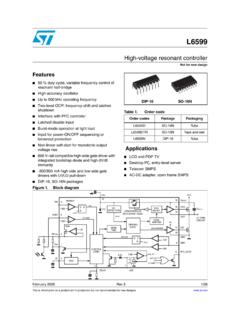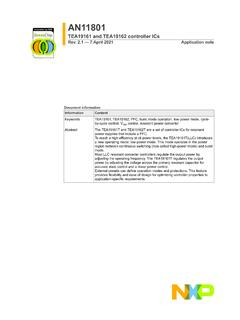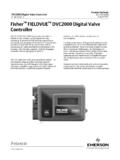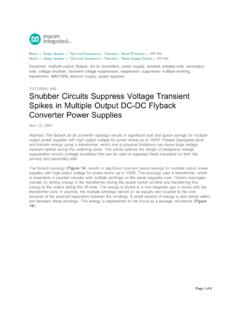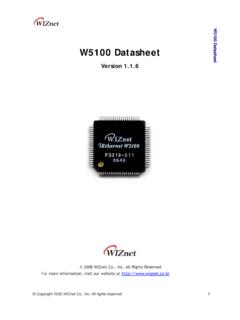Transcription of LLC Resonant Converter for Battery Charging Application
1 International Journal of Electrical Engineering. ISSN 0974-2158 Volume 8, Number 4 (2015), pp. 379-388. International Research Publication House LLC Resonant Converter for Battery Charging Application G. Subitha Sri and Dr. D. Subbulekshmi School of Electrical Engineering, VIT University, Chennai Associate professor, School of Electrical Engineering, VIT University, Chennai Abstract This paper describes about the LLC Resonant Converter used for the Battery Charging Application . LLC Resonant converters have many advantages when compared with other converters in terms of high efficiency, less switching losses. It is also capable of operating in narrow switching frequency where zero current switching can be achieved.
2 This Converter is designed for the output range of 15V-20V with a input of 30V, with a efficiency ranging from 88~92%. Low conduction loss and low switching loss are the two important characteristics of the Resonant converters. This feature makes the proposed topology in the Application of Battery Charging . With the help of the constant voltage high efficiency is obtained and regulated by closed loop control. Simulations of both open and closed loop are performed and their design procedures are included. Keywords LLC Converter , zero current switching (ZCS), Battery charger, PI controller . INTRODUCTION. As the concern about the global warming, fuel depletion, and some of environmental issues the use of hybrid electric vehicle are increased.
3 The Battery used in vehicle should be in such a way that it should satisfy the features such as smooth and quick Charging , high power density, high efficiency. By improving the capacity of voltage and current the algorithm for batter Charging becomes complicated. The most commonly used Battery Charging architecture is shown in fig. 1 It consist of mainly two stages, namely power factor correction PFC stage and DC-DC Converter stage. The power factor correction stage is a continuous conduction mode of boost topology. 380 G. Subitha Sri and Dr. D. Subbulekshmi In this paper the main focus is the DC-DC Converter which plays an important role in Battery charger by regulating the output current and voltage.
4 The characteristics of the Battery depend on this stage[1]. LLC converters are selected as a suitable Converter because of this various features such as wide operating range, high efficiency, low electromagnetic interference, high power density, soft switching at both primary and secondary sides. From the fig 1, it is inferred that when the AC input is given to the PFC stage the boost voltage is obtained which is combined with the DC link and given as input for the DC-DC Converter . The Converter provides the constant voltage for the Battery to be charged. In this paper half bridge LLC Converter is designed for the output voltage range of 15V-20V for a lead-acid Battery with the input range of 30V.
5 The circuit is simulated using PSIM software and the output voltage is regulated with the help of PI controller as a feedback path. In Section II operation of LLC Resonant Converter is discussed. In Section III circuit operation and in Section IV design procedure of the Converter is discussed. Section V explains the simulation results. Fig 1. Block Diagram of Battery Charger. LLC Resonant Converter . Generally the Resonant converters can be in form LLC or LCC configurations. Fig 2. a, represents the LLC network where two inductors and capacitors are present. Fig 2. b, represents the LCC network where two capacitors and one inductor are used.
6 LLC. networks are capable of obtaining the soft switching over wide range of operations when compared with the LCC network. The size of the converters can be reduced in LLC network by combining inductors as transformer. LLC Resonant Converter for Battery Charging Application 381. Fig 2. a, LLC Resonant tank Fig 2. b, LCC Resonant tank A. LLC Series Resonant Converter . Fig 3, represents the proposed half series Resonant LLC Converter , which is a high efficiency DC-DC Converter . The main parts of this Converter are (i) Switching Network (ii) Resonant tank and Transformer (iii) Rectifier and Filter. Switching Network: The switching network which controls the frequency of the network acts as a square wave input DC with a duty cycle of 50% for each switch.
7 The switch used to control the frequency is MOSFETs. Some dead time are introduced between the switches in order to obtain zero voltage switching. When the dc input is given to the switching network it converts the input signal into square wave with a fixed duty ratio of amplitude equal to input voltage. Resonant Tank and Transformer: The inductor Lr, capacitor Cr forms a Resonant Converter . The energy is transferred to the load with the help of transformers when the Resonant Converter allows the current to circulate. When the switching network is combined with Resonant tank it forms a Resonant inverter. The output of the Resonant Converter will be a sinusoidal voltage which is fed as an input for the transformers.
8 Depending upon the turn's ratio of the transformer gain is determined and electrical isolation is provided. Rectifier and Filter: As the output of the transformer is a sinusoidal voltage, they are rectified by full wave rectifier. The diodes D1, D2 with center tapped transformer forms a full wave rectifier[2]. Now the AC input will be rectified as a constant DC. output voltage with the help of the filter circuits at the secondary side of the transformer. Fig 3, Proposed Resonant LLC Resonant Converter 382 G. Subitha Sri and Dr. D. Subbulekshmi III. OPERATION OF LLC SERIES Resonant Converter . The energy delivered to the load is controlled by the impedance of the Resonant tank by varying the switching frequency.
9 LLC Resonant Converter operates in two frequencies. First frequency involves Lr, Cr and second frequency involves Lr, Cr, and Lm. (1). (2). Equation 1 represents the frequency at no load condition. And equation 2 represents the frequency with load conditions. But the LLC converters are designed in such a way that . The frequency depends upon the gain of the transformer. The power flow from the input to the load side is controlled by the switching frequency. Depending upon the range of frequencies LLC Converter has three modes of operation. They are (i) Below resonance (ii) At resonance (iii) Above resonance At Resonance: When the switching frequency is equal to the Resonant frequency the Converter said to be operated in resonance condition.
10 During this period when the switch S1 is turned off, the Resonant current will be equal to magnetizing current where there will be no power transfer between the source and the load. Zero current switching is obtained due to the dead time switching between the switches. Below Resonance: When the switching frequency is greater than Resonant frequency, then the Converter is in below Resonant mode. Here the Resonant current will be equal to the magnetizing current before the switch turns off and the power is delivered to the load. If the fr1 frequency is less than switching frequency zero voltage switching can be obtained through out the operation, if fr2 is greater than switching frequency then zero voltage switching may be lost due to high switching losses.

